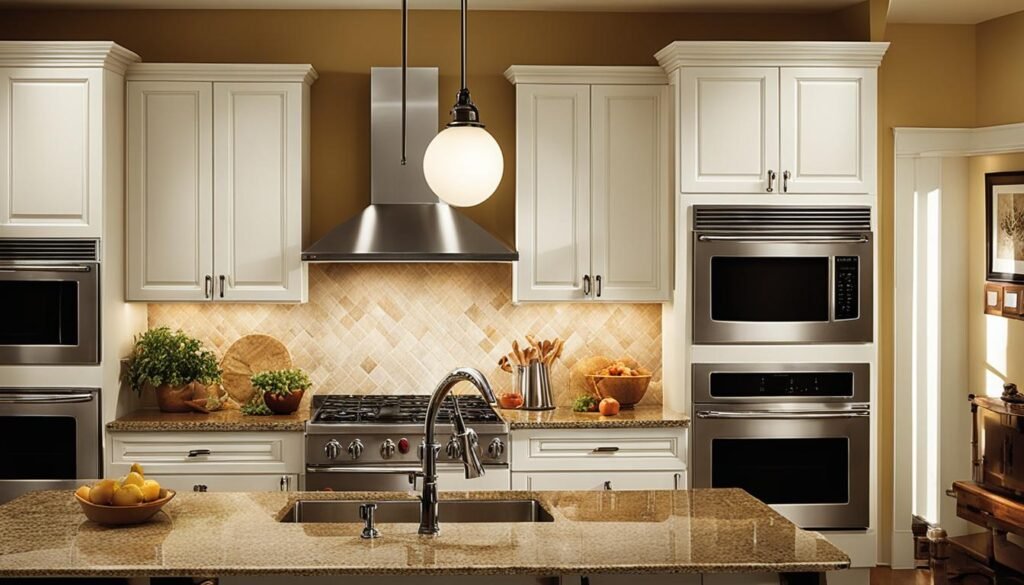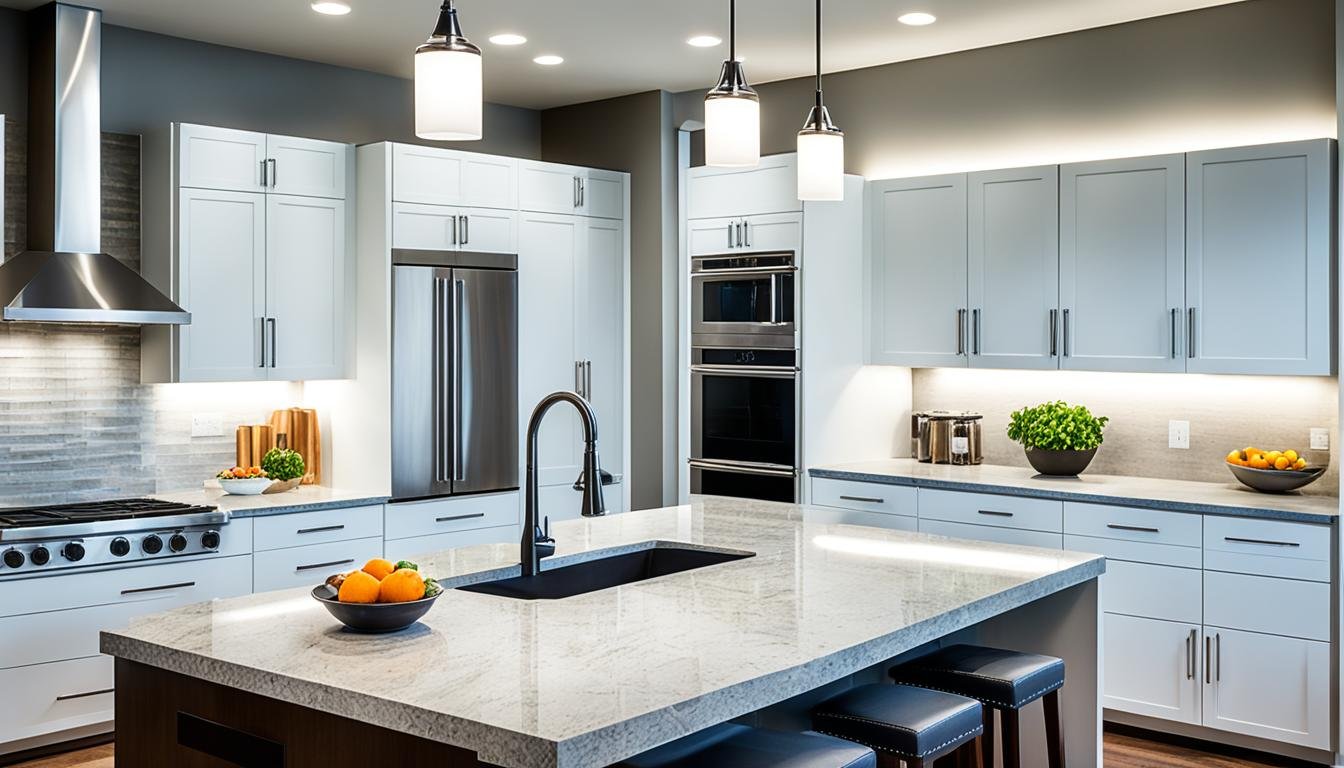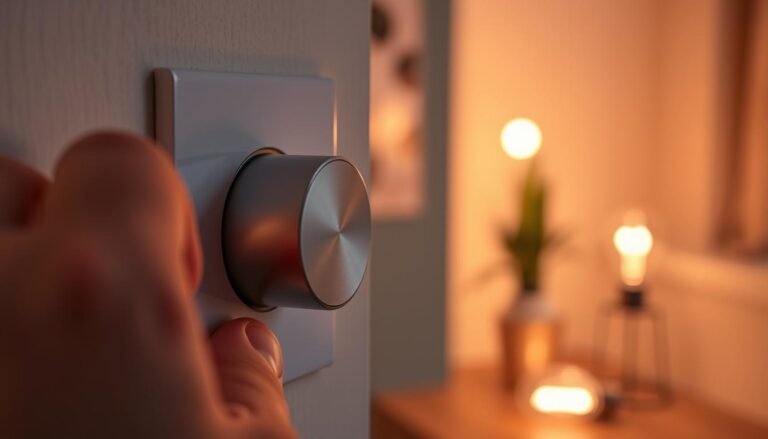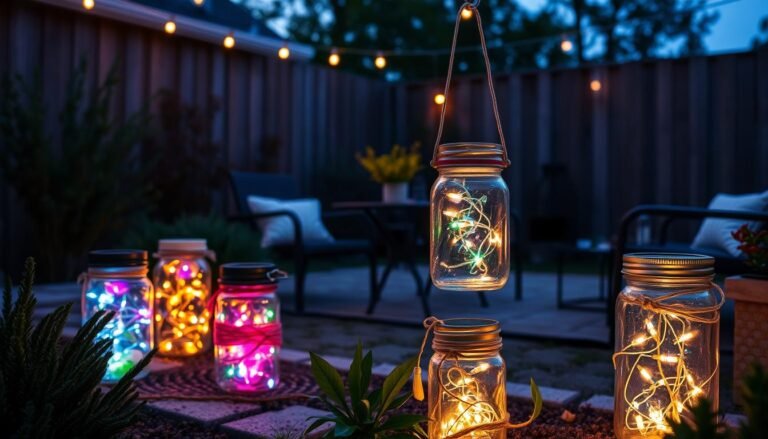Affiliate Disclosure: This post may contain affiliate links. If you make a purchase, we may earn a small commission at no extra cost to you.
Designing the lighting for your kitchen involves more than just picking pretty fixtures that match your decor. It’s important to consider the functionality of the lighting to create a bright and functional space. So, how can you design the perfect kitchen lighting setup that meets both your aesthetic and practical needs?
In this article, we will explore 9 essential tips to help you design the ideal kitchen lighting. From overhead lighting to under cabinet kitchen lighting, pendant lighting to recessed lighting, we will cover it all. So, get ready to transform your kitchen into a well-illuminated and inviting space.
Key Takeaways:
- Consider both the aesthetic and functional aspects of your kitchen lighting design.
- Explore various types of lighting, including overhead, under cabinet kitchen lighting, pendant, and recessed lighting.
- Use a layered approach to create a cohesive and balanced lighting scheme.
- Pay attention to task lighting in high-activity areas such as the sink and stove.
- Choose the right fixtures and strategic placement for ambient lighting.
1. Natural Light Maximization Strategies for Kitchen Lighting
Natural light is a valuable asset in any kitchen, as it creates a bright and inviting atmosphere. Maximizing natural light can enhance the overall design and functionality of your kitchen. In this section, we will discuss strategies to maximize natural light and make the most of the available sunlight.
Assessing Your Kitchen’s Natural Light Sources
The first step in maximizing natural light is to assess the existing natural light sources in your kitchen. Take note of the windows and their placement. Are there any obstructions such as trees or buildings that may block sunlight? Identify areas where natural light enters your kitchen throughout the day.
Assessing your kitchen’s natural light sources will help you determine the best areas to optimize natural light and plan your lighting setup accordingly. This allows you to strategically place artificial light sources where they are needed most, supplementing the natural light and ensuring a well-lit space even during darker hours.
Optimal Window Treatments for Enhanced Luminosity
Choosing the right window treatments can significantly enhance the luminosity in your kitchen by allowing more natural light to enter the space. Consider opting for treatments that maximize natural light while maintaining privacy and controlling glare.
Here are some window treatment options to consider:
- Sheer curtains or lightweight fabrics that allow natural light to filter through.
- Transparent blinds or shades that can be fully or partially opened, depending on the desired level of privacy and light control.
- Sidelight curtains or café curtains that cover only the lower portion of the windows, allowing natural light to enter from the top.
- Solar shades or window films that reduce glare and heat while still allowing ample natural light to illuminate the space.
Choosing the optimal window treatments allows you to maximize natural light in your kitchen while maintaining your desired level of privacy and control over lighting conditions.
Door Upgrades for Increased Sunlight Flow
Doors that connect your kitchen to an outdoor space, such as a patio or garden, can be great natural light sources. Upgrading your doors to ones with larger or additional windows can increase the flow of sunlight into your kitchen.
Consider the following door upgrades:
- French doors with multiple glass panels that allow maximum natural light into your kitchen.
- Sliding glass doors that offer unobstructed views and ample sunlight.
- Patio doors with sidelights that provide additional sources of natural light.
Door upgrades not only enhance the natural light in your kitchen but also create a seamless connection between indoor and outdoor spaces, making your kitchen feel more expansive and inviting.
2. Layered Kitchen Lighting: Creating a Cohesive Scheme
Layered lighting is an essential aspect of kitchen lighting design that allows you to create a cohesive and balanced lighting scheme. By incorporating different layers of lighting, including ambient, task, and accent lighting, you can achieve a well-illuminated and visually appealing kitchen.
Start by selecting the right ambient lighting fixtures, such as recessed lights or track lighting, to provide overall illumination and set the mood in your kitchen. These fixtures create a soft, diffused light that fills the entire space.
Next, consider task lighting to meet the specific lighting needs of different areas in your kitchen. Install under cabinet kitchen lighting to illuminate the countertops for food prep, pendant lights above the kitchen island for focused lighting, and range hood lighting for the cooking area. Task lighting helps you work efficiently and adds a functional element to your kitchen.
To add depth and visual interest, accent lighting is key. Use spotlights or recessed lights to highlight architectural features, artwork, or decorative elements in your kitchen. This creates a layered effect and draws attention to specific areas, enhancing the overall ambiance.
To create a cohesive lighting scheme, it’s important to understand how these layers of lighting complement each other. For example, you may choose warm-toned ambient lighting fixtures and task lighting with a similar color temperature to create a harmonious blend of light throughout your kitchen.
When designing your kitchen lighting, keep in mind the functionality, aesthetics, and the specific areas that require lighting. By combining ambient, task, and accent lighting thoughtfully and strategically, you can achieve a cohesive lighting scheme that enhances the overall design and functionality of your kitchen.
3. Task Lighting: Meeting the Demands of High-Activity Areas
In high-activity areas of your kitchen, such as the sink, stove, food prep areas, and islands, task lighting plays a crucial role in providing adequate illumination for your tasks. With the right task lighting, you can ensure that you have the visibility you need to perform everyday kitchen activities with ease and precision.
Several types of task lighting are commonly used in kitchen design:
- Under-cabinet lighting: This type of lighting is installed underneath the upper cabinets, directly illuminating the countertop. It helps eliminate shadows and provides focused light for tasks such as cutting vegetables or reading recipes.
- Pendant lighting: Pendant lights are often used to bring an additional layer of task lighting to specific areas, such as over the kitchen island or dining table. They provide concentrated light and can also serve as decorative elements in your kitchen.
- Range hood lighting: Range hoods equipped with built-in lighting are essential for illuminating the cooking surface. They ensure that you have clear visibility while cooking and also add a stylish touch to your kitchen.
Implementing task lighting effectively in your kitchen involves considering the placement and spacing of the fixtures. For example, in work areas like the sink and stove, it’s important to position the task lighting fixtures directly above for optimal illumination. In the case of pendant lighting, consider the height and size of the fixtures to ensure they provide enough light without obstructing your line of sight.
Task lighting enhances both the functionality and aesthetics of your kitchen. It not only makes it easier to perform tasks, but it also adds depth and visual interest to the space. By strategically incorporating under-cabinet kitchen lighting, pendant lighting, and range hood lighting, you can create a well-lit kitchen that meets all your high-activity needs.
4. General Ambient Kitchen Lighting for Overall Brightness
Ambient lighting plays a crucial role in creating a well-lit and inviting atmosphere in your kitchen. It provides overall brightness and ensures that the entire space is adequately illuminated. To achieve balanced illumination throughout your kitchen, it’s important to carefully select the right fixtures and strategically place them. Let’s explore how you can choose the perfect fixtures for ambient light and achieve a harmonious lighting scheme.
Choosing the Right Fixtures for Ambient Light
When selecting fixtures for ambient lighting, consider options that provide soft and diffused light. Recessed lights are a popular choice for ambient lighting as they can be discreetly installed and offer a clean and streamlined look. Flush-mount or semi-flush-mount fixtures are another great option, providing a wide spread of light and blending seamlessly with various kitchen styles. Chandeliers can also be used for ambient lighting, adding a touch of elegance and sophistication to your kitchen.
Whatever fixtures you choose, make sure they have the appropriate wattage to create the desired level of brightness. Opt for LED bulbs as they are energy-efficient and long-lasting, reducing both your electricity bills and the need for frequent bulb replacements.

Strategic Fixture Placement for Balanced Illumination
To achieve balanced illumination in your kitchen, it’s essential to strategically place your ambient light fixtures. Start by considering the layout and size of your kitchen. Identify areas that may be prone to shadows or dark spots and ensure that you have adequate fixtures in those locations.
Distribute the fixtures evenly throughout the space to prevent any areas from being overly illuminated or poorly lit. Aim for uniform brightness without any harsh contrasts. For larger kitchens, you may need multiple fixtures to ensure sufficient coverage.
In addition to the general overhead lighting, consider integrating ambient lighting into other areas of your kitchen, such as above cabinets or in alcoves. This will create a warm and inviting ambiance, further enhancing the overall lighting scheme.
By choosing the right fixtures and strategically placing them, you can achieve a balanced and well-illuminated kitchen that is both functional and visually appealing.
5. Accentuating Details with Accent Kitchen Lighting
Accent lighting is a great way to add a decorative touch to your kitchen while highlighting specific features or areas of interest. By incorporating accent kitchen lighting, you can create a warm and inviting atmosphere that showcases the beauty of your kitchen design.
One way to utilize accent lighting is by installing lights inside glass-door cabinets. This not only adds an elegant touch to your kitchen but also provides a soft glow that showcases your finest china or glassware. It creates a focal point and adds depth to your kitchen space.
Another way to highlight architectural features in your kitchen is by using accent lighting. Consider installing lights above corbels or coffered ceilings to draw attention to these unique design elements. The accent lighting creates an ambiance that enhances the overall aesthetic of your kitchen.
When choosing accent lighting fixtures, opt for styles that complement your kitchen’s theme and décor. This will ensure a cohesive and visually appealing look. Additionally, positioning the lighting fixtures strategically will help focus attention on the desired area.
With accent kitchen lighting, you can create a stunning visual impact in your kitchen, accentuating its details and adding a touch of elegance and style.
6. Create a Focal Point in Your Kitchen
Creating a focal point in your kitchen can add personality and style to the space. One effective way to achieve this is by choosing a bold light fixture with a unique design. A statement chandelier or a modern kitchen lighting fixture can instantly become the centerpiece of your kitchen, drawing attention and creating a visually captivating focal point. The distinct design elements of these fixtures will make them stand out and become a conversation starter for guests.
For example, consider a bold, industrial-style pendant light with exposed bulbs hanging above your kitchen island. This will not only provide functional lighting but also contribute to the overall aesthetic of your kitchen. The unique design of the light fixture will make it a focal point that complements your kitchen’s style and adds a touch of contemporary elegance.
Another option for creating a focal point is by using a collection of pendant lights above an island. This arrangement adds visual interest and draws the eye towards the center of the kitchen. You can choose pendant lights with different shapes, sizes, and colors to create a dynamic and visually appealing display.
To ensure a cohesive and balanced lighting design, it’s important to consider how the rest of the lighting fixtures in the kitchen complement the main focal point. The surrounding lighting should enhance and accentuate the bold light fixture or pendant lights, rather than competing with them. This can be achieved by opting for simpler and understated lighting fixtures in other areas of the kitchen, allowing the focal point to truly shine.

In this example, a bold and visually striking pendant light is installed above the kitchen island, becoming the focal point of the space. The rest of the lighting fixtures, such as recessed lights and under cabinet kitchen lighting, are designed to complement the main focal point, allowing it to take center stage.
By creating a focal point with kitchen lighting, you can transform your kitchen into a visually captivating space that reflects your unique style and design sensibilities. Whether you choose a bold light fixture or a collection of pendant lights, these unique design elements will elevate the overall aesthetic of your kitchen and make it a truly standout space.
7. Consider Your Kitchen View from Other Rooms
When designing your kitchen lighting, it’s essential to consider how it will look from other rooms in your home, especially with open floor plans. A cohesive design that seamlessly blends your kitchen into the overall style of your home is crucial. One way to achieve this is by selecting fixtures that not only match the aesthetic of your kitchen but also tie in with the surrounding rooms.
To create a visually appealing and cohesive look, opt for fixtures that have a similar design language to the ones in the adjacent spaces. This doesn’t mean they have to be identical, but they should have complementary elements. For example, if you have modern pendant lights in your dining room, consider selecting pendant lights with a similar style for your kitchen island, thus creating a modern kitchen lighting effect.
By considering your kitchen view from other rooms, you can create a harmonious and well-coordinated lighting design throughout your entire home.
8. Combating Glare with Strategic Kitchen Lighting Fixtures
Glare can be a common issue in the kitchen if not properly addressed. It can cause discomfort and make it difficult to perform tasks efficiently. However, by strategically selecting and placing lighting fixtures, you can effectively combat glare and create a more comfortable and visually appealing kitchen.
Impact of Surfaces on Kitchen Lighting Clarity
The surfaces in your kitchen can affect the clarity of your lighting and contribute to glare. Smooth and highly reflective surfaces, such as glossy countertops or shiny appliances, tend to reflect light more intensely, resulting in glare. By choosing matte or textured surfaces, you can reduce the amount of glare and create a softer, more diffused lighting effect in your kitchen.
Smart Choices to Soften and Diffuse Light
In addition to selecting the right surfaces, there are several smart choices you can make to soften and diffuse light in your kitchen:
- Use diffusers: Diffusers are accessories that attach to lighting fixtures to distribute light evenly and reduce harsh shadows and glare. They come in various shapes and sizes and can be easily installed on pendant lights, chandeliers, or recessed lights.
- Opt for light housings: Light housings, also known as light baffles or light shields, can be added to recessed lights to control the direction and intensity of the light. They help minimize glare by shielding the light source and directing it downward onto the desired area.
- Consider frosted or etched glass: If you’re using glass shades for your lighting fixtures, consider opting for frosted or etched glass. These types of glass scatter and diffuse the light, reducing glare and creating a softer illumination in your kitchen.
By implementing these smart choices, you can effectively soften and diffuse light, minimizing glare and creating a more comfortable kitchen environment.

9. Use Lighting Controls, Especially Dimmers
When it comes to designing your kitchen lighting, don’t overlook the importance of lighting controls, particularly dimmers. Lighting controls give you the power to adjust the lighting levels according to your specific needs and preferences. They offer flexibility and customization, allowing you to create the perfect mood in your kitchen.
One of the key benefits of using dimmers is that they provide adjustable lighting. Whether you need bright and vibrant lighting for cooking and food prep or a softer, more intimate ambiance for a romantic dinner, dimmers allow you to easily achieve the desired effect. With just a twist or slide of a switch, you can instantly transform the atmosphere in your kitchen.
Lighting controls, including dimmers, also offer a degree of lighting customization. You can have different lighting scenes or presets programmed in your kitchen lighting system to suit various activities or occasions. For example, you might have a “Morning Boost” setting that provides bright, energizing lighting in the morning, and a “Relaxation” setting that creates a soothing, calming ambiance in the evening.
Furthermore, dimmers allow you to control and manage energy consumption. By being able to decrease the brightness when it’s not necessary, you can save on electricity costs and extend the lifespan of your light bulbs. Dimming the lights also helps prevent glare, providing a more comfortable and visually pleasing environment in your kitchen.
Whether you’re hosting a lively gathering or enjoying a cozy night in, lighting controls with dimmers offer the perfect solution for enhancing your kitchen lighting. With adjustable lighting, customization options, and energy-saving benefits, dimmers provide the flexibility you need to create the ideal atmosphere for any occasion.
Explore the wide range of lighting controls available, and consider incorporating dimmers into your kitchen lighting design. Harness the power of adjustable lighting to customize your kitchen illumination and set the mood just right.
Conclusion
In conclusion, a well-designed kitchen lighting setup is essential for both functionality and aesthetics. By implementing the 9 essential tips discussed in this article, you can create a kitchen that is well-illuminated and perfectly suited to your needs and style.
Consider the natural light sources in your kitchen and optimize them by choosing the right window treatments and considering door upgrades to increase sunlight flow. Utilize layered lighting techniques by incorporating ambient, task, and accent lighting to create a cohesive and balanced lighting scheme.
Task lighting is crucial in high-activity areas, so be sure to install appropriate lighting fixtures such as under-cabinet lights, pendant lights, and range hood lights. For overall brightness, choose the right fixtures for ambient lighting and strategically place them for balanced illumination. Additionally, utilize accent lighting to highlight specific features or areas of interest in your kitchen.
Remember to create a focal point in your kitchen with a bold light fixture or a collection of pendant lights, and ensure that the rest of the lighting fixtures complement the main focal point. Consider the view of your kitchen lighting from other rooms, especially in open floor plans, to maintain a cohesive design. Finally, combat glare by selecting the right lighting fixtures and using diffusers and light housings to soften and diffuse light.
By incorporating lighting controls, such as dimmers, you can customize the lighting levels in your kitchen and create the desired mood. With careful consideration of both functionality and aesthetics, you can design a well-illuminated and functional kitchen that enhances your cooking and dining experience. Happy designing!
FAQ
How important is natural light in kitchen lighting design?
What are the different layers of lighting in kitchen design?
Which areas in the kitchen require task lighting?
What are some options for ambient lighting in the kitchen?
How can accent lighting be incorporated into a kitchen design?
How can I create a focal point in my kitchen with lighting?
Should I consider the view of my kitchen lighting from other rooms?
How can I combat glare in the kitchen?
What are the benefits of using lighting controls in the kitchen?
Check out our FREE Calculators on our Resources Page




